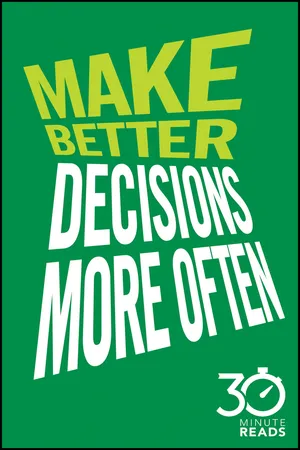
Make Better Decisions More Often: 30 Minute Reads
A Short Cut to More Effective Decision Making
- English
- ePUB (mobile friendly)
- Available on iOS & Android
Make Better Decisions More Often: 30 Minute Reads
A Short Cut to More Effective Decision Making
About this book
You're half an hour away from never making a bad decision again!
Why not use your next spare half an hour to skill-up? Each of these short e-books can be read in just 30 minutes. Addressing those painful work problems, and giving practical tools and expert advice to overcome them, the 30 Minute Reads series will make your work-life more productive, less painful and more successful!
Decision making not your strong suit? Fed up of thinking 'I should have chosen the other candidate/strategy/sandwich'? This succinct, practical guide will teach you how to properly weigh up all the information and make well thought out decisions more quickly.
Also available in a digital bundle with 4 other titles as part of 30 Minute Reads: The business skills collection.
Make Better Decisions More Often will help you:
- Identify the problem and what isn't working
- Discover the 10 Big Strategies
- Put in place your super-structured, super-easy, 5-day count-down plan to no more pain.
Frequently asked questions
- Essential is ideal for learners and professionals who enjoy exploring a wide range of subjects. Access the Essential Library with 800,000+ trusted titles and best-sellers across business, personal growth, and the humanities. Includes unlimited reading time and Standard Read Aloud voice.
- Complete: Perfect for advanced learners and researchers needing full, unrestricted access. Unlock 1.4M+ books across hundreds of subjects, including academic and specialized titles. The Complete Plan also includes advanced features like Premium Read Aloud and Research Assistant.
Please note we cannot support devices running on iOS 13 and Android 7 or earlier. Learn more about using the app.
Information
The Challenge
The Detail
The Story
The Solution
The Challenge
Table of contents
- Cover
- Title page
- What will this book do for you?
- 1: The Decision Process
- 2: Tools to Decision Making 1: Data and evidence
- 3: Tools to Decision Making 2: Analysis
- 4: Tools to Decision Making 3: Brainstorm and incubation
- 5: Tools to Decision Making 4: Boosting creativity
- 6: Tools to Decision Making 5: Take action
- 7: Decisions at Work 1: Teamwork
- 8: Decisions at Work 2: Persuading, convincing and selling
- 9: Decisions at Home
- 10: Your Action Plan
- About the Author
- Copyright page
- End User License Agreement